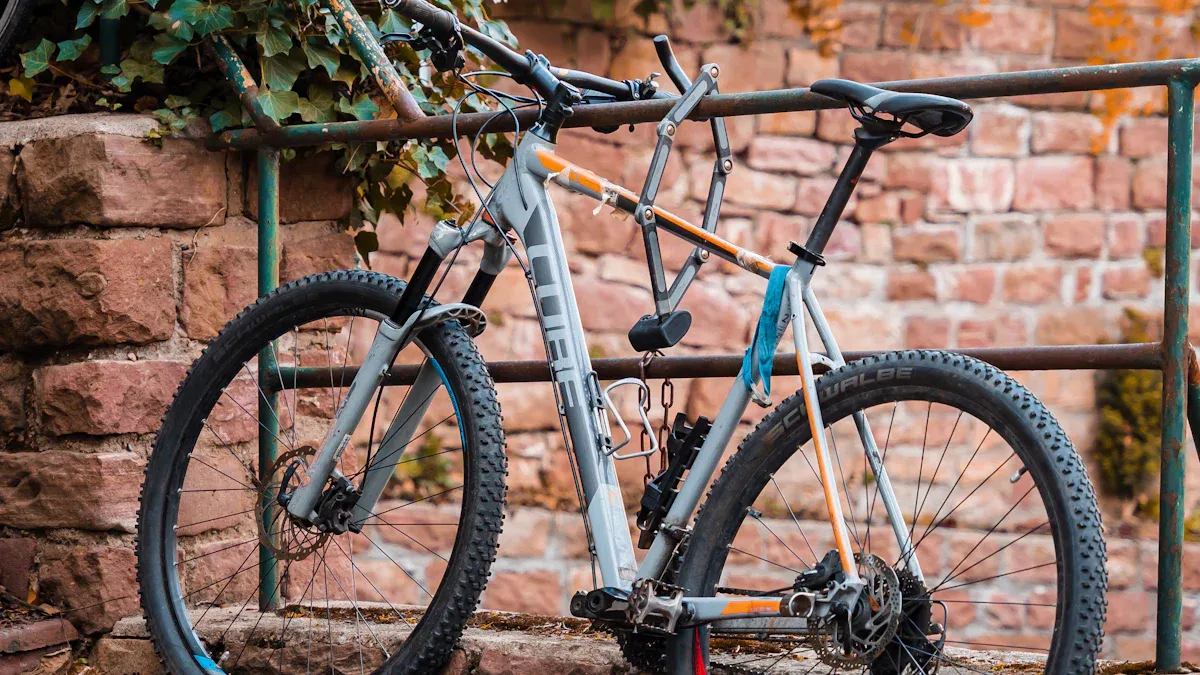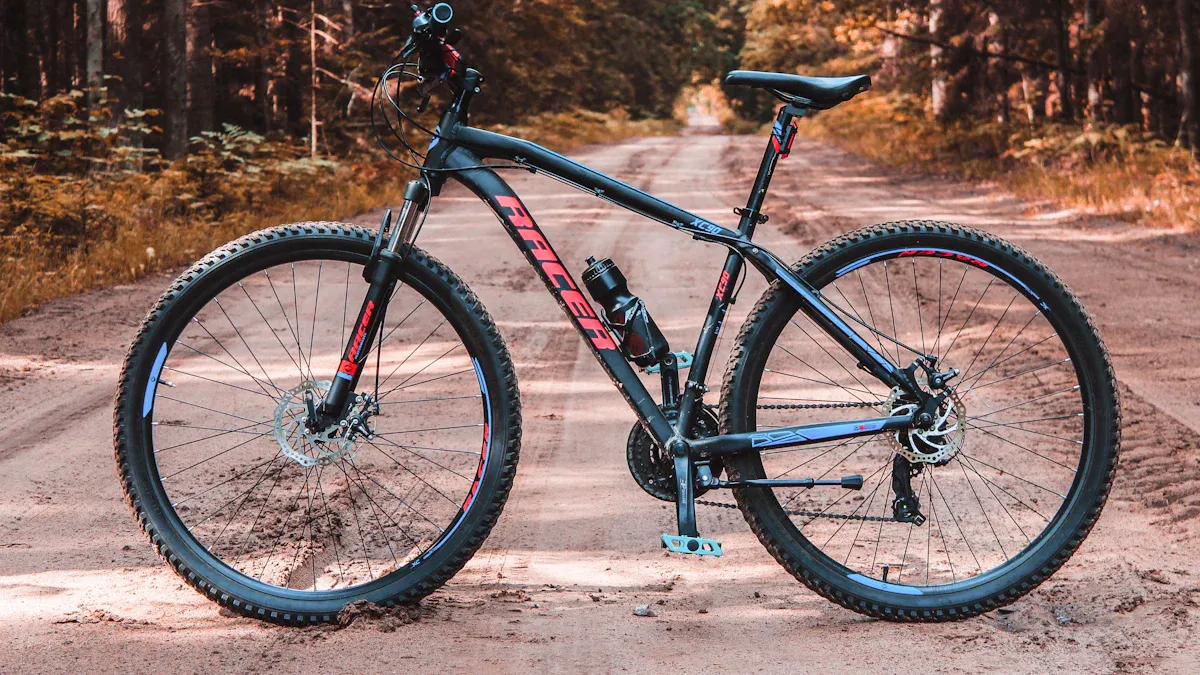
Mountain bike frame shapes are very important for your ride. They affect how well your bike works on different surfaces. They also change how comfortable you feel while biking. The three main types of mountain bikes are:
Rigid: Simple and light, great for smooth paths.
Hardtail: A mix of speed and comfort, good for cross-country rides. About 65% of mountain bikes sold worldwide are in this group.
Full-suspension: Made for rough paths, giving you better control and boosting your confidence.
Picking the right frame shape for your riding style and the terrain you ride on can really improve your performance and comfort.
Key Takeaways
Mountain bike frames have three main types: rigid, hardtail, and full-suspension. Each type works well for different riding styles and terrains.
Rigid frames are light and efficient. They are great for smooth trails. They give excellent energy transfer and are often cheaper.
Hardtail frames balance speed and comfort. They are flexible, need less maintenance, and work well on many terrains.
Full-suspension frames are best for rough trails. They give better control and comfort. They are perfect for aggressive riding and downhill fun.
Picking the right frame shape can improve your riding experience. Think about wheel size, suspension type, and fit to find the best bike for you.
Rigid Mountain Bike Frame Shapes

Key Features
Rigid mountain bike frames have a simple design. They do not have any suspension parts. This means you feel the ground directly. This design makes the frame light. It is often made from materials like steel, aluminum, titanium, or carbon fiber. Each material has special qualities:
Material | Durability | Weight Comparison |
|---|---|---|
Steel | Strong, flexible, easy to fix | Heavier than aluminum |
Aluminum | Rustproof, stiff, rough ride | 12% stiffer, 20% lighter than steel |
Titanium | Corrosion resistant, durable | Similar strength to steel, lighter |
Carbon Fiber | High strength for its weight | Very light, but costs more |
This table shows how different materials change the durability and weight of rigid frames. You can pick a frame based on what you want for weight and strength.
Advantages
Rigid mountain bike frames have many benefits. First, they are great at using energy. When you pedal, all your energy helps move the bike. This makes them perfect for smooth trails and cross-country rides.
Rigid frames are the best at energy transfer. They turn all your leg power into movement.
They are also usually cheaper than other frame types. For example, a steel diamond frame can cost about $1,100. Complete bikes can cost between $1,800 and $2,249.
Another plus is their strength. Good aluminum or carbon frames can last 5–10 years if you take care of them. You will have fewer problems compared to hardtail or full-suspension bikes, which need more repairs.
Hardtail Mountain Bike Frame Shapes
Key Features
Hardtail mountain bike frames are special because of their design. A hardtail bike has a strong, one-piece frame with a suspension fork in the front. This makes hardtails different from rigid bikes, which have no suspension, and full-suspension bikes, which have suspension in the front and back. Here are some key traits of hardtail frames:
Hardtail frames are strong and one piece.
They have a front suspension fork but no back suspension.
Hardtails are lighter and usually cheaper than full-suspension bikes.
This design helps you feel more connected to the ground. You can sense the bumps and dips, which can help you improve your riding skills over time.
Advantages
Picking a hardtail mountain bike frame has many benefits, especially for certain riding styles and terrains. Hardtails make up 62.1% of the global mountain bike market. They are popular because they are strong and cost less than full-suspension bikes. Here are some benefits of hardtail frames:
Efficiency: Hardtails are great at using energy. When you pedal, almost all your energy moves the bike forward. This makes them perfect for smooth singletrack and long climbs.
Lower Maintenance Costs: Hardtail bikes are easier and cheaper to take care of. They need less servicing than full-suspension bikes, which have more parts. This simplicity means lower costs over time.
Versatility: Hardtails work well on many types of terrain. Whether you are an XC racer, a long-distance rider, or a tough trail rider, hardtails can handle smooth paths, gravel roads, and even tricky downhill rides.
Tip: If you like long rides on gravel paths or tricky singletrack, a hardtail might be the best choice for you.
Full-suspension Mountain Bike Frame Shapes

Key Features
Full-suspension mountain bike frames have a special design. They include suspension systems in the front and back. This setup helps the bike handle bumps on rough trails. Here are some important features of full-suspension bikes:
Dual Suspension: These bikes have a suspension fork at the front and a shock absorber at the back. This helps you deal with bumps and drops better.
Improved Traction: The back suspension keeps the tires on the ground. This helps with grip, especially on uneven surfaces.
Comfortable Ride: The suspension system lessens the impact from rough paths. You can have a smoother ride, even on tough trails.
This design makes full-suspension bikes great for aggressive riding and hard terrains.
Advantages
Choosing a full-suspension mountain bike frame has many benefits, especially for certain riding conditions. Here are some advantages you can expect:
Enhanced Control: With full suspension, you get better control of your bike. You can handle tricky trails and steep hills with confidence.
Increased Comfort: The suspension absorbs shocks, making long rides more fun. You can ride longer without getting tired.
Versatility: Full-suspension bikes do well in many places. Whether you ride on rocky trails, steep slopes, or muddy paths, these bikes adjust easily.
Tip: If you want to ride on rough terrain or enjoy downhill trails, a full-suspension bike might be the best choice for you.
Overall, full-suspension mountain bike frame shapes offer a mix of comfort and performance. They are perfect for riders looking for adventure on tough trails.
Specialized Mountain Bike Frame Shapes
Mountain bike frames come in different shapes. Each shape is made for certain riding styles and terrains. Knowing these differences helps you pick the right bike for your adventures.
Enduro Frames
Enduro frames are great for going downhill. They have a longer wheelbase and a slacker head tube angle. This makes them more stable when going down hills. Here are some important features:
Suspension Travel: Enduro bikes usually have 160-180mm of front suspension and 160-170mm in the back. This helps you ride rough trails with confidence.
Frame Design: These frames are made from light materials like aluminum or carbon fiber. This mix of strength and lightness helps you climb better while being tough on descents.
Downhill Frames
Downhill frames are made for aggressive riding. They have special features that make them different:
Suspension Travel: These bikes often have 200mm or more of suspension travel. This helps them absorb big bumps from jumps and rough ground.
Durable Frame: Downhill bikes use stronger and heavier materials. This helps them handle the stress of fast descents.
Trail Frames
Trail bikes balance climbing and descending well. They have moderate wheelbases and head tube angles, making them good for many terrains. Here’s what to expect:
Suspension Travel: Trail bikes usually have 130-160mm of front suspension and up to 150mm in the back. This setup gives you a smooth ride on climbs and descents.
Geometry: The shape of trail bikes helps you control the bike better, making them good for tricky trails.
Cross Country Frames
Cross-country bikes focus on climbing well. They have shorter wheelbases and steeper angles, which help with agility. Here are some details:
Suspension Travel: Cross-country bikes usually have 100-120mm of rear suspension. This design helps you keep speed when climbing.
Material Specifications: Common materials are carbon fiber and aluminum. These keep the bike light while still being strong.
Wheelbase | Head Tube Angle | Reach | Suspension Travel | |
|---|---|---|---|---|
Enduro | Longer | Slacker (63-64º) | Longer | 160-180mm front, 160-170mm rear |
Trail | Moderate | Steeper (64-66º) | Shorter | 130-160mm front, up to 150mm rear |
Cross Country | Shorter | Steeper | Shorter | 100-120mm rear |
Choosing the right frame shape depends on how you ride and the terrain you like. Whether you enjoy downhill biking or cross-country rides, knowing these specialized frames will help you make a smart choice.
In short, knowing about mountain bike frame shapes is important for improving your ride. You learned about three main types: rigid, hardtail, and full-suspension. Each frame has special features and benefits for different terrains and riding styles.
When picking a frame, think about these key points:
Wheel Size: Bigger wheels go over bumps easily, while smaller wheels are easier to turn.
Suspension: Hardtail bikes are great on smooth trails, while full-suspension bikes give you better control on rough paths.
Fit: A good fit makes riding comfortable and helps you perform better.
As you ride more, your frame needs might change too. Choose carefully to enjoy every ride! 🚴♂️
FAQ
What is the best mountain bike frame for beginners?
A hardtail frame is usually the best choice for beginners. It gives a nice mix of comfort and efficiency. It also costs less to maintain. You can ride smooth trails and learn basic skills without too much difficulty.
How do I know what size frame to choose?
To find the right frame size, measure your inseam. Then, check the size chart from the manufacturer. A good fit helps you feel comfortable and in control while riding. You should feel steady and confident on your bike.
Can I upgrade my mountain bike frame later?
Yes, you can upgrade your mountain bike frame later. Many riders start with a simple frame and change to a better one as they get better. Just make sure your parts work with the new frame.
What frame material is the lightest?
Carbon fiber is the lightest material for bike frames. It is very strong for its weight, which is great for racers. However, it can cost more than aluminum or steel frames.
How does frame geometry affect my ride?
Frame geometry affects how your bike handles, feels stable, and is comfortable. A steeper angle helps you climb better, while a slacker angle gives you more control downhill. Pick a geometry that fits your riding style and the terrain you like for the best ride.
See Also
Understanding The Differences Between Fat And Mountain Bike Frames
Simplifying Large Sizing And Geometry For Mountain Bike Frames
Key Factors To Think About For E-Mountain Bike Frames
